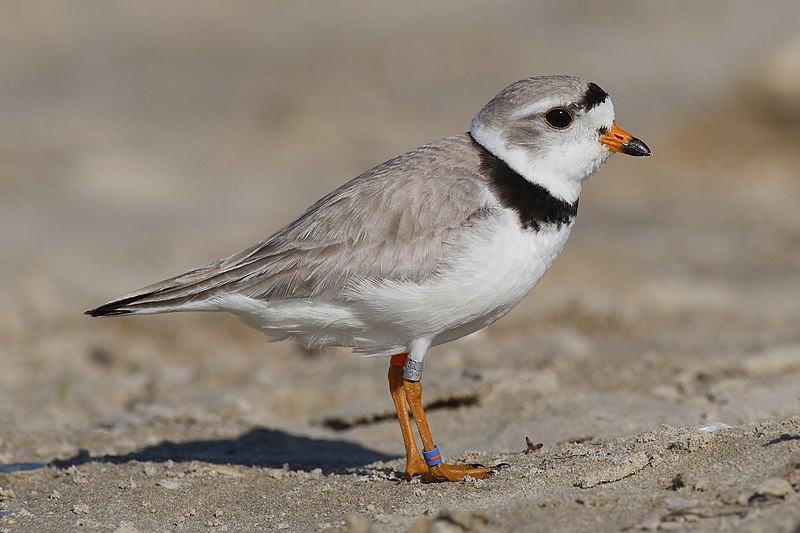Listed as an endangered species in 1986, the piping plover is a small shorebird that struggles with finding well-kept nesting habitat and simply surviving through the disturbance from other animals and the uninformed public. It is a very small bird that I had the pleasure of observing yesterday on an island designated as a protected wilderness area in New Jersey. Pictured below is an adult plover, taken from the Wikipedia page.

Found nesting along the Atlantic coast and Great Lakes in the United States, this small sand-colored bird stands at a mere 6 to 7.5 inches once full grown. While I was monitoring the nests, the adults I saw seemed so much smaller and blended in very well with the surrounding sand and seashells. The call they emit is short and difficult to discern among many other calling birds. It took me a while to finally hear its call, and I'm sure I won't be able to forget it. Not requiring any vegetation to consume or nest, the ideal habitat is among sandy beaches or rocky coasts. Pictured below are some photos I took of the island where they were nesting.


Migrating south for the winter, towards Florida and even the Bahamas, the nesting season of these birds starts in mid-May and continues on into the beginning of summer. Because of the limited numbers and large availability of suitable habitat for the birds in New Jersey, there are areas under federal protection solely for the purpose of maintaining an area for nesting and closed to the public for the duration. During this season, employees, or in this case interns, of Edwin B. Forsythe National Wildlife Refuge take on the task of observing and monitoring the birds and the nests. Adult pairs are sought out first, fueling the hope for many nests and chicks. Once eggs are starting to be laid, interns observe the adults and attempt to seek out the nests. This is done by noting the behavior of the adults. They are a territorial bird and nest with a large amount of space between each other. If a bird seems to be calling a lot and going through the broken-wing display in an attempt to get your attention, chances are there is a nest somewhere very close by. The job of finding the nest isn't easy, though. The adult will attempt to lead you away from the nest, and it is then imperative to watch each step that is taken. Even when you have an idea of where the nest is located, it can blend in so very well. Because it consists of a scrape in the sand, often decorated with broken seashells, it can be easily bypassed. The fact that the eggs are sand colored doesn't help either. Once the nest is finally found, the job of the intern is to make notes on the location and leave the nest as soon as possible, in order to avoid further stressing the adults. With many predators to fend off, even without the addition of the general human public, nests will sometimes be enclosed in wire fencing, leaving just enough room for an adult to fit through. Foxes, raccoons, gulls, and crabs are still clever, though. Monitors of the nests try their best to protect it, but the designation of an area as a federally protected wilderness area prevents it from being altered or aided in any way. The fate is left up to nature. Interns will make frequent checks, though, and chicks will be observed to be sure the eggs did hatch and weren't eaten. I was able to see three, and they were simply specks moving across the sand, standing at 2 inches when hatched. Pictured below are some of the nests from the area I was at and photos of a chick and broken-wing display, taken from Wikipedia and RedBubble.

Piping Plovers will lay up to 4 eggs, usually one every other day. They will often re-nest if something destroys the first nest.
Only so much can be done to try and maintain the population of a truly amazing little bird, and I love knowing that there are people out there who care. It is my hope that more people will make the attempt to help and protect in any way possible, and I enjoy knowing that I can help in making the first step through education.












































